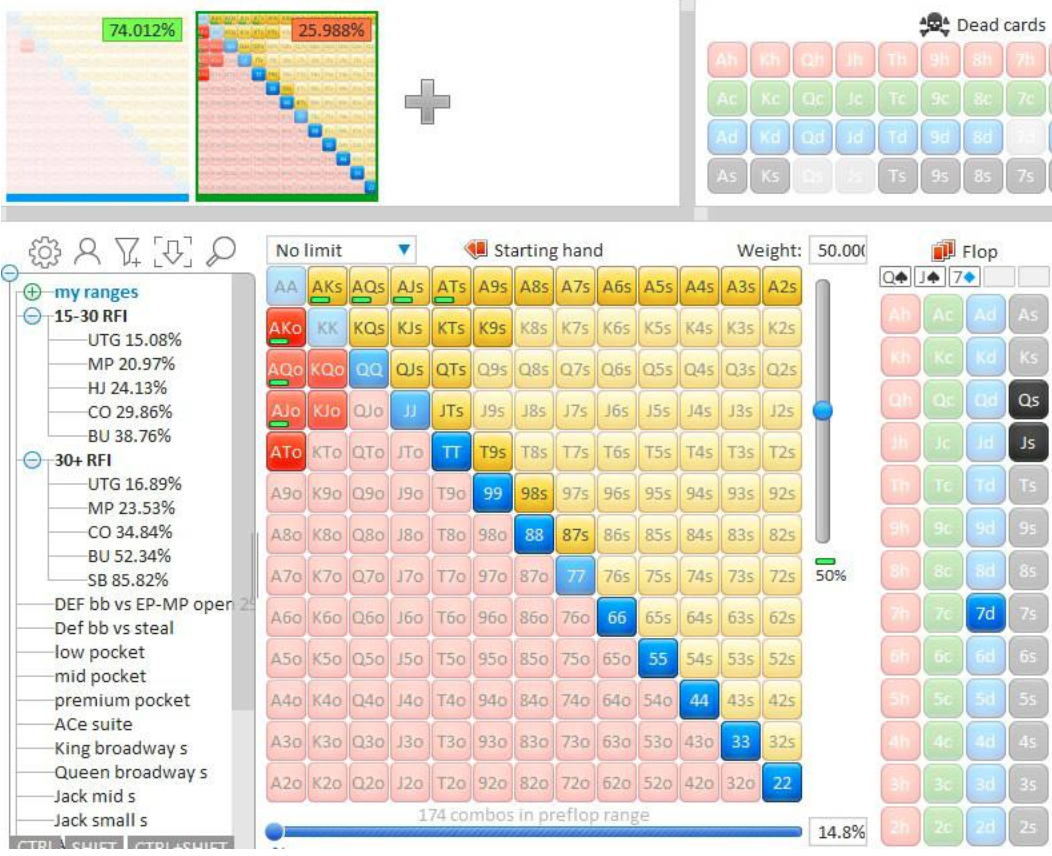Translated with the help of AI. We apologize for any errors and would appreciate your help in correcting them.
In microlimit poker, it is very often necessary to face situations when several players are fighting for the pot at once. Such pots, called multipots, require a special approach, as they strongly affect the equity of the hands played and the optimal strategy of the game. Let's take a closer look at how to play multipots correctly.
1. The main differences between multipots and standard heads-ups
The main difference between multipots is the increase in the number of opponents at the table. The more of them there are, the less chance each individual player has of winning a particular hand.
When you play one-on-one, you have about a 50% chance of winning with a medium hand. But if there are three opponents against you, then your chances are already only about 25%. This is important to understand so as not to overestimate the power of your cards. For example, the top pair on the flop in a one-on-one hand usually gives an advantage. But in the multipot, the same top pair can no longer be the first combination at the table.
- Let's analyze a specific example: We have
a flop
in the multipot against players on CO and BB. Rivals here can have a variety of (including stronger than ours) hands:
In heads-up versus one player with one,
we could count on 70-75% equity. And in the multipot against two players, our equity falls to about 55-60%, which is a very significant decrease. In the described hand, we should be careful on all streets, it would be right not to make large bet, so as not to invest with our hand in a big pot, if our bet does not force both rivals to fold. You can bet from 1/3 to half of the pot for protection and fine selection (depending on the stage of the tournament and the size of your stack). If we receive a raise in the course of the hand, it is most likely worth fold ing KQ, given the likely combinations of opponents. We will discuss post-flop in more detail in the next article.
Thus, in the multipot, we have to play much more carefully even with the top pair, due to the drop in relative equity compared to heads-up.
Another feature is that the raise of the enemy in the multipot often means a strong hand than the raise in the classic one-on-one hand. Players understand that they are opposed by several opponents at once, so they choose a stronger range for aggression. But bluff in multipots works much worse. Against two or three opponents, the probability that at least one of them will continue the game with some equity is much higher. Therefore, bet even in semi-bluff will often be losing.
In multipots, you can try bluffing against the following types of players:
- Tight nits. They will often drop draw and even some medium strength pair on aggression. The main thing is that they do not have a ready-made strong hand.
- Players prone to tilt. If they start to get angry and play more aggressively, it will be more difficult for them to defend in a balanced way in multipots. The position and statistics per player are of particular importance.
- Fans of passing on the river. Some opponents avoid difficult decisions on the river and often folds. You can try to bluff them.
- Players fond of semi-bluffing. If someone often puts on the flop and gives up on the later streets, then they can be attacked with a check/raise and a bluff on the turn.
If there are no statistics, then you need to focus on a live impression of the opponent's game. See how often he bet, how he defends himself and whether he uses a semi-bluff. Behavior at the table can also be used to judge the tendency to tilt. Keep a close eye on opponents and write notes. Based on these features, we can say that you need to play multipots more conservatively and selectively. Range for calls, bet, protection should be already normal. And bluff and semi-bluff should be used less often and more carefully and only against specific opponents in favorable conditions.
2. Effect of multipot on hand equity
Equity in poker is a mathematical indicator of the relative strength of your hand against the supposed range of your opponent. For example, AKo has about 60% equity against the classical range for a call at the BTN position. This means that before the flop, we have a 60% chance of winning the one-on-one hand.
However, in the multipot, the situation changes. The range of each individual player at the table becomes already due to increased selectivity. Increased selectivity in the context of poker means that players become more selective in the choice of starting hands for the game. In multipots, increased selectivity is manifested in the fact that players play a narrower, premium range of hands compared to classic one-on-one hands.
- For example, in an early heads-up position, a player can open with a very wide range - from 22+, A2s+, K7s +, etc. And in the multipot, the same player will play a call much more tight - playing only strong hands like TT+, AK, AQ.
Reasons for increased selectivity in multipots:
- More players at the table = less chance of winning with each particular hand.
- There is a high risk of being dominated against a narrow range of rivals.
- Less fold equity when betting.
As a result, the same cards lose in relative strength, that is, in equity. Our AKOs no longer dominate the ranges of opponents in the bank for 3-4 people so much. It is likely that someone will have an older pair or even a premium hand like KK or AA, which is clearly ahead. Therefore, the AKo equity may fall to 40% or close to this figure. This must be taken into account when making decisions in multipots, so as not to overestimate the strength of your cards. Hands that we used to consider very strong in classic one-on-one hands often turn out to be only marginal in multipots.
3. Playing cold circle in multibank from free positions and with BB
Consider the features of the cold call game in multipot from the early positions and from the big blind. On preflop from weak positions such as MP, MP2, HJ, the call should be entered selectively – as with good hands, or only with a good stack.
Example:
- AQo, AQs, AJs, KQs (20bb + stack)
- AJo, KJs, ATs, 88-TT are added with a stack of 25bb+
- 22-77 with a stack of 35bb+
This is due to the danger of domination, when several more players can make a raise behind you. It is better to immediately fold the suited connectors or weak ace, even if you get good pot-odds. After all, even by flopping a monster, you can find yourself behind your rivals. Players can block our hands on straight or flush, be older. And against 3-4 opponents, the chances of catching the desired outs are small. The price of playing in a big pot will be high. But on the big blind, the situation changes, as we are guaranteed to see the flop, no matter what happens next.
Therefore, a wider range can be played here, including suited connectors and gaps:
- A9o-AJo, KTo-KQo, QTo, QJo, 76o-JTo, 22-88, 87s-T9s, J7s-JTs, Q7s-QJs, K7s-KQs, A2s-AJs
By getting a free card, we compensate for the drop in equity relative to the ranges of opponents. If the monster comes to the flop, then you can aggressively play on, despite the multipot.
4. Playing through Squeeze from different positions
Squeeze is a reraise bet in two or more rivals on a preflop. When one player raises, the second responds with a call, and then the third announces a reraise - this is the classic Squeeze. The main goal is to knock opponents out of the hand or narrow the game to heads-up. Squeeze from early positions (EP-MP) is better to use with a fairly narrow range - top pairs, AK and sometimes AQ. You can add a little bluff hand, such as 78s, 67s, A5s for balance. But at later positions like CO, BTN, there is space to expand the squeeze range due to single-mass connectors and gapers.
On the button, a light Squeeze with some Broadway cards like KQ, QJ is also appropriate. On the blinds, especially on SB, there are even more options for squiz thanks to good pot odds. You can add suited aces and other speculative hands with potential. The main thing is to do the Squeeze only with a weighted range, and not squeeze any two random cards. Thus, the closer to the big blind our position is, the more aggressively you can squeeze. But in any case, it is important to take into account the gaming trends of specific opponents in order not to overdo it.
5. Conclusions
Summing up, we note the main points of the game in multipots:
- Narrow the range for bet, call and protection due to the fall of the equity of hands with an increase in the number of opponents;
- Use semi-bluff and pure bluff less often, and do it only against suitable opponents;
- Selectively play call from early positions, but use a wider range on blinds;
- Apply the Squeeze on strong hands, carefully expanding the range of the squeeze depending on the position.
Competent ajusting of the strategy to the features of multipots will allow you to effectively play hands with the participation of many players and profit from such difficult situations. In the second part of the article about multibanks, we will touch on the post-flop game and analyze various current issues and game situations.
If we are a pre-flop aggressor:
- the influence of the number of callers on the preflop strategy of the aggressor;
- when to put a c-bet in a bluff, and when it is better to abandon it;
- how to choose sizing of c-bet on vellya and with dro-hands.
If we are a pre-flop-collector:
- reaction to the cbet of the preflop aggressor on the flop;
- options when the preflop aggressor is waiting checks.
The strategy of playing in checked banks. And also we will analyze the main faces of the field in the game in multipots.







